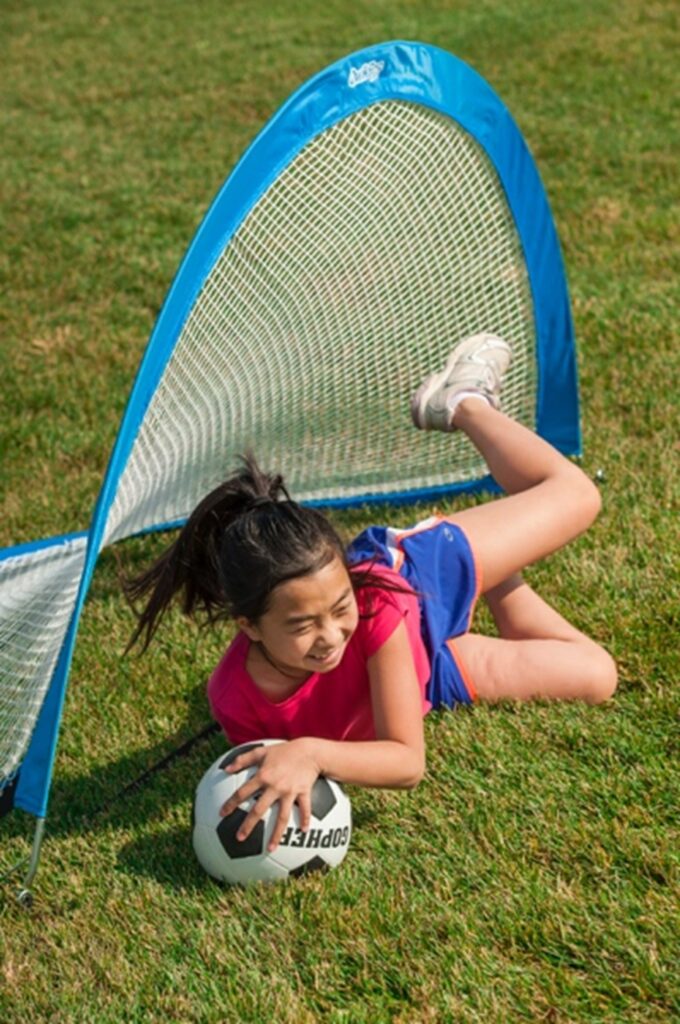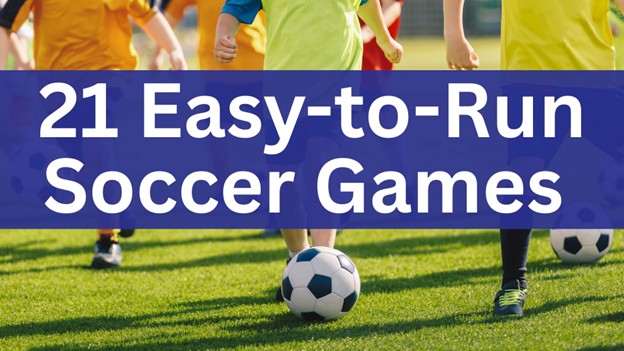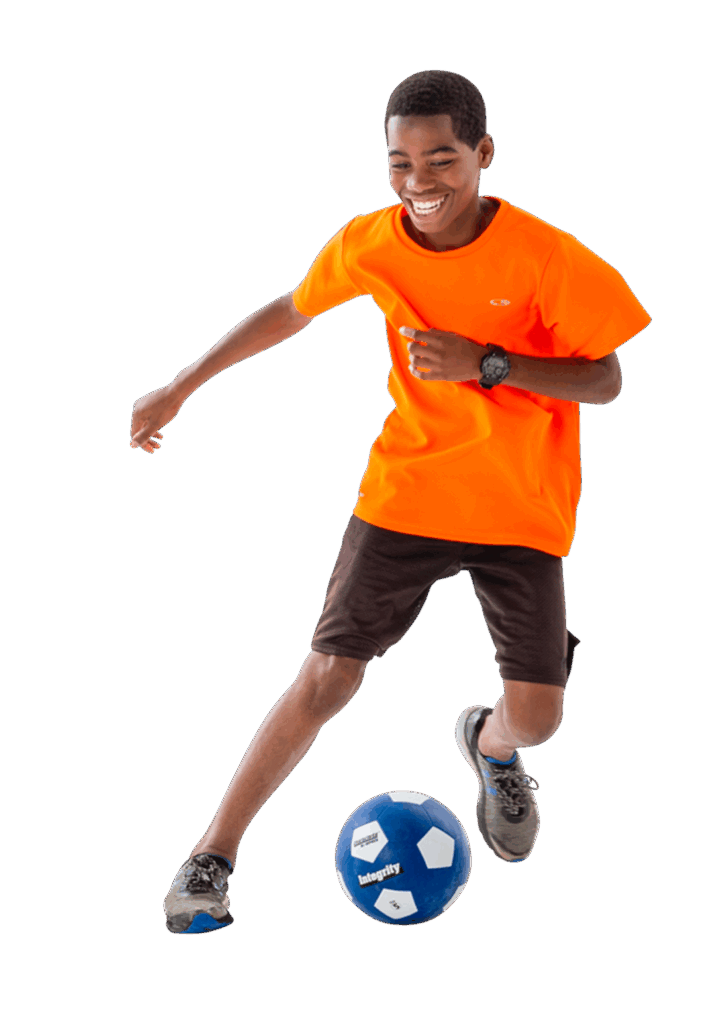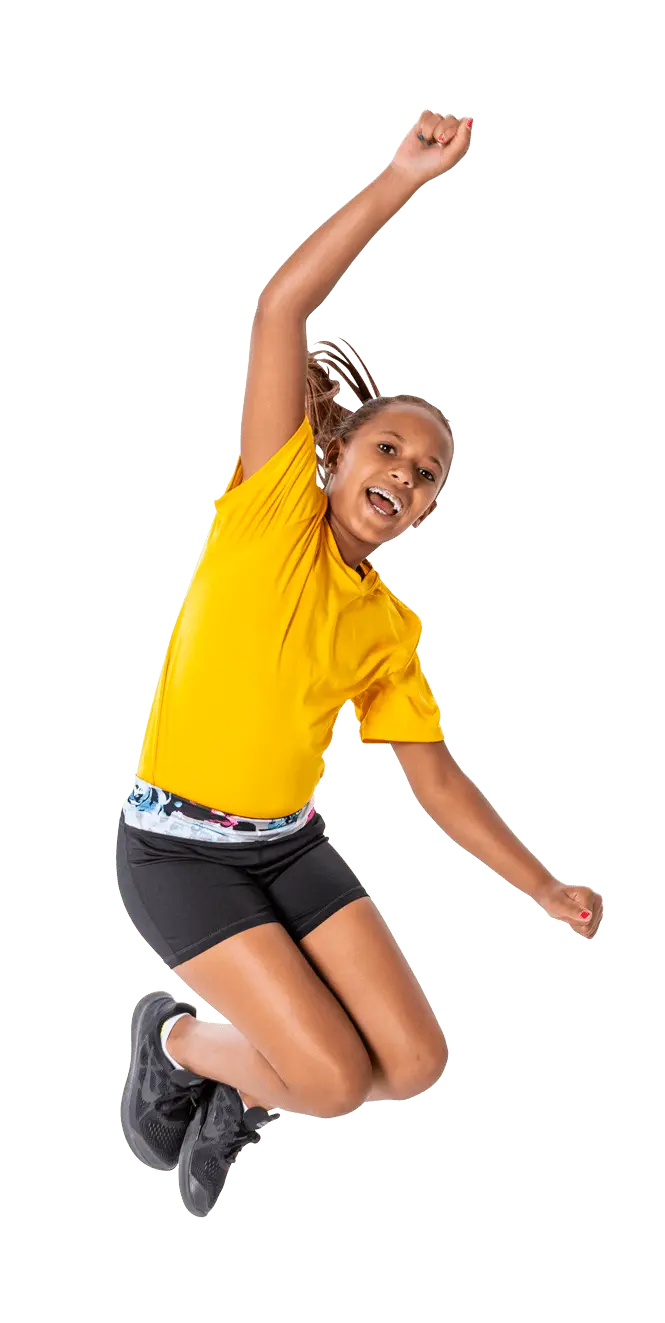
Soccer is a great sport for all ages and has always been one of my favorites to teach and coach. Soccer is inherently a creative game and teaches itself. It is important to design skill sessions and games with maximum opportunities for each student to improve their skills and confidence- use more balls, goals and small sided or individual play.
Ball control and spatial awareness are the first things I teach. Every participant should know empty space and how to move to empty space. Use the basketball court boundaries in the gym or make a “soccer box” with cones for playing on the field. I start with a warm-up with the different parts of the foot, using inside, outside, instep (laces), bottom and the heel. All participants should practice keeping the ball close and moving to empty space inside of the space. I also add little in place challenges like bottom of the foot touches, inside of the foot touches, forward jumps over the ball and others. You can also add skills like pull backs, step-overs, fakes, stop and go’s etc.

1. Soccer Freeze Tag
One ball per student. Use pinnies to designate taggers.
All are dribbling their ball. Taggers attempt to tag someone to “freeze” them. Once tagged, they are frozen and put their ball on their head and make a goal with their legs. To get “unfrozen”, someone must pass a ball through their legs. More advanced groups can play with more taggers and/or restricted space.
2. What Time Is It Mr. / Mrs. Fox?
One ball per student.
Play from one end of gym to the other or use lines.
The group begins the class by asking, “What time is it Mrs. Fox”? If Mrs. Fox says “[6:00]”, everyone takes 6 steps (not 6 kicks) and stops. When Mrs. Fox says “MIDNIGHT”, all must dribble their ball to opposite end line and try not to get tagged. If they make it, they stay there; if they get tagged, then they become a “fox”. I have the “foxes hold their ball under their arm and tag with the free hand.
3. Red Light-Green Light
One ball per student.
One coach acts as the “police office” and stands in the middle of gym
On a “Red Light”, students must stop their ball with their feet. “Yellow Light” means slow and “Green Light” means go. If their ball is moving on a “Red Light , they must go back to the beginning or do a # of ball touches, # of jumps over the ball or et cetera. Use the same penalty if they stop the ball with their hands or lose control of their ball.
The object is to get to the other side as quickly as possible without getting a “ticket” from he police officer. If they make it across, they should stay there and wait for the next round.
4. Snake Tag
The “snake” is in the middle and calls players by favorite color or color of pinnie (et cetera). When called, players must dribble their ball to the opposite end line without getting tagged by the snake. If they are tagged, they put their ball away and join hands with the “snake”. As the snake gets longer, it will be harder to get to the other side!
5. Team Tag
Use pinnies to designate two teams. Each player has a ball and tries to tag an opposing player. If tagged, the player is “out” of the game and they can watch by the side or do some soccer skills until the round is over.
6. Sheep and Wolves
Use pinnies to designate the sheep and wolves. All have a ball and are dribbling inside a restricted space. When the coach calls a color, that team becomes the wolves and they leave their ball and try to tag or kick the sheep’s ball before they get to the designated “safe area”. If a sheep makes it to a safe area they get one point. Have several safe areas designated by cones.
7. Sharks and Minnows
Sharks are in the middle without a ball. Minnows have a ball and begin at one end of gym. The game starts when the sharks yell “SHARKS” and then the minnows yell “MINNOWS” and then they try to dribble their ball to the opposite end line without a shark kicking their ball. If a shark kicks their ball, they put it away and become a shark for the next round. If the minnow makes it across safely, they stay at the end line and wait for the next round. Ease into this game with younger classes.
8. Kick-out
Everyone has a ball. Players must control their ball and stay inside a restricted space while they try to kick another player’s ball out. If your ball is kicked out, you are out or must do a soccer/fitness related skill before re-entering the game.
Restrict the space to make the game more challenging.
9. Follow the Leader
One ball per pair.
The person without the ball is the “leader” and they travel at a controlled speed through empty space, changing directions but not going too fast that the one with the ball cannot follow. Whenever the leader “feels like it”, they stop and make a soccer goal with their legs and the player following must kick it though and then switch roles.
Once they get this, a game of 1v1 can be added for points. Once the ball is kicked through the leader’s legs, they chase it out and whoever wins possession gets a point and keeps the ball. This is a lot of fun and a good workout!
10. Hospital Tag or Band-Aid Tag
Everyone has a ball. You can have the coaches be the taggers (best with younger classes), designate several taggers with pinnies or play that everyone is a tagger. If you are tagged, put a “Band-Aid” where you were tagged (place your hand where you were tagged). Once you get tagged three times, go to the “hospital” (side of gym or playing space) and do a certain number of skills: 5-10 jumps over ball, juggles, foot touches, et cetera. Once you have done those exercises, you get back into the game without any Band-Aids on. Ease into this game with younger classes.
11. Ball Possession Game
All have a ball except 4-5 who do not have a ball. This is a great way to teach soccer concepts of “ball pressure” and “shielding”. If they have a ball, they should keep possession of it and protect it by shielding/controlling it. If they do not have a ball, they should try to “challenge” someone to try to win the ball and then keep possession of that ball. Try to go the whole game without losing your ball.
12. Cone Game
Same as the ball possession game but now if you have a ball, you can also try to score “cone goals” by knocking down a cone with a good soccer kick. Emphasize stopping ball at an empty cone and good kicking technique (step next to ball with plant foot and use the inside or instep of kicking foot). This game can be played with teams or partners as well!
13. Alternate Version of Cone Game
This one is great for younger classes! Set up lots of cones (10-20) and scatter them in empty space. If there is a cone standing up, they should knock it down using a good soccer kick (step next to cone and use top or inside of foot to kick it). If they see a cone that is down, they should stand it up using their feet (step next to cone and use the bottom of the foot to stand it up). This game can also be played with two teams where one team has to knock down cones and the other has to stand them up.
14. Clean up the Backyard
Divide the class into two teams and give one team the pinnies. Each team must stay on their side of the “fence” and try to kick the ball across to the other side using good passing technique (plant foot/inside of foot). Have students alternate their kicking foot each time they kick so that they practice on their weak foot too. Play for several minutes and then see who has the “cleaner” backyard.
15. Soccer Marbles
This is a great passing game but needs to be played in a large space. Each player has a ball and a partner. Begin in empty space with the balls separated. The first player gets one kick to hit the other player’s ball. If successful, the player gets one point; if the ball misses, let the ball rollto a stop and the 2nd player gets one kick to aim and try to hit the other player’s ball. When a point is scored, separate the balls and continue to play. Remember, each player gets only one kick or touch per turn.
16. Windows
Play in partners with one ball per pair. Use cones to set up several small goals throughout the gym. Partners work together to score points by passing through the “window”. You can add a defender or play that one pair does not have a ball and once they steal the ball away from a group, they try to keep possession of it and score points by completing passes through the “windows”.
17. Keep Away
Play with a large or small group with one or multiple defenders wearing pinnies. This game can be played with one or multiple balls. Passers try to maintain control of the ball while the defenders try to pressure the ball and steal it away. When a defender steals the ball, whoever touched it last becomes a defender.
Teach ball pressure, passing angle (safe pass) player support (position to help your teammate) and accurate passing. You can also impose restrictions like the #of touches each player is allowed or space restrictions.
18. Numbers
Designate two teams by pinnies. Give each player a number. Call out a specified amount of numbers and play small sided soccer for a designated length of time or until a goal is scored.
Players need to be able to remember their numbers!
19. 4 Ball, 4 Goal, 4 Team Soccer
Divide the class into 4 teams and each team has a different colored pinnie. Each team has a goalie and starts with one ball. Each team must protect their goal and may try to score on any of the opposing goals. Rotate goalies.
This game works well with large classes give lots of opportunities for individual skills and team play.
20. 2 Team Multi-Ball Soccer
This works great in instructional classes because it gives students an opportunity to get lots of touches on the ball and work on ball pressure, ball control, give and go passing. I always review some of the things they can do if they have possession of a ball: control it, pass to a teammate or take a shot on goal. If they don’t have a ball, they should pressure someone on the other team and try to steal it away or go to a “passing angle” away from your teammate who has a ball, so they can pass it to you.
With younger classes, I usually get parent “volunteers” to play goalie so that the coaches can work with their team on passing and other aspects of the game.
21. Small Sided Games
Set up some goals and divide into teams. Give the kids a ball and let them play!
“Backyards”, “playgrounds” and “streets” are some of the best places to learn the game and have fun playing it.
Soccer is a game that teaches itself. Let the kids play!

Sample Unit Plan for 5 Sessions:
Session One:
- Attendance/review signals for stop and go.
- Ball control warm-up using different parts of feet.
- Soccer Freeze Tag
- What time is it Mr. Fox? Or Red Light-Green Light .
- Ball Possession Game.
- Cone Game.
Session Two:
- Attendance/Names.
- Ball control warm-up with parts of feet.
- Ball possession game.
- Soccer Freeze Tag.
- “Red-Light-Green Light” or “Sharks and Minnows”.
- Multi-ball game play.
Session Three:
- Attendance/Names.
- Ball control warm-up with parts of the feet.
You could add another element like stop on whistle or pull-back and change directions on a whistle.
- Hospital tag or Freeze Tag.
- Keep away or Cone game
- Multi ball Game
Session Four:
- Attendance.
- Ball Control warm-up.
You could add some feints/fakes to this or “give and go passing” to coach. Juggling skills could also be added.
- Students choose 2-3 ball control warm-up games to play.
- Clean-up Backyard: Emphasize good kicking technique!
- Multi-ball game
Session Five:
- Attendance.
- Choice of favorite games.
- Multi-ball game.
Basic soccer skills and concepts:
Passing: Non-kicking foot placed beside the ball, pointed in the direction of the intended target. Use the inside of the foot with the head over the ball for greatest accuracy and control. Spend time practicing with both feet!
Receiving: Use the inside of your foot with toes pointed up (make a “V” with your ankle). You can also use the bottom of your foot. “Cushion” the ball, rather than let it bounce away. Try to look up to see where the defenders and teammates are before touching the ball.
Shooting: Use the instep (top of foot or shoelaces) for greatest power. To “lift” the ball, step slightly behind and lean back a bit. Upper corners of the net are high percentage shots.
Ball control: Use all different parts of the foot. Try to keep the ball one step away. Try changes of speed and pathways, stop and go, fakes and feints. Be creative!
Shielding: Use the bottom of the foot and outside of the foot to protect the ball. Try to use your body to keep the defender away from the ball.
Ball pressure: Move with feet apart, keeping one foot slightly in front of the other (slant). When the ball is “shown”, go after it and try to win possession
Goal keeping: Always be in a good “ready position”. The first priority is to move and get into position to stop the ball. For a ball above the waist, make a “W” with your fingers up; for a ball below your waist, make an “M” with your fingers pointed down. Bring the ball into the bank (chest) to keep it safe.
Ball pressure: When the opposing team has the ball, there should always be immediate defensive pressure. The defender is slowing down the attack. Have a “cushion” space to slow the attacking player and a “slanting” defensive posture. There should only be one defender on the ball, not the entire team! Teach the concept of “first defender”, “2nd defender”.
Ball possession: Keep possession of the ball until there is defensive pressure. When there is a defensive threat, the player needs to decide if they will try to beat the defender, pass or take a shot on goal.
Passing angle or angle of support: This is simply a safe pass. Teammates should try to move into a position where the ball can be safely passed to support the player with the ball. The player in possession of the ball can also help to create safe passes. Team communication is an important part of effective passing.





